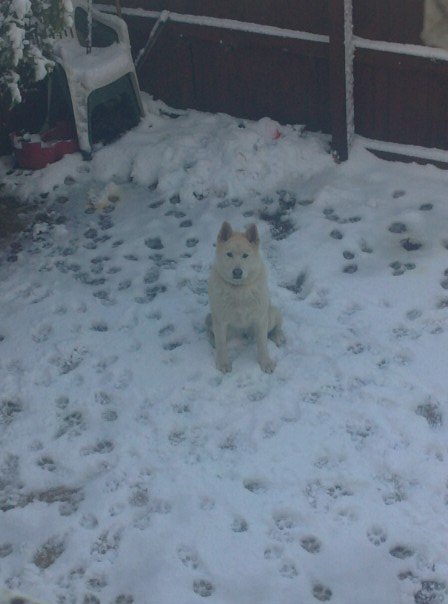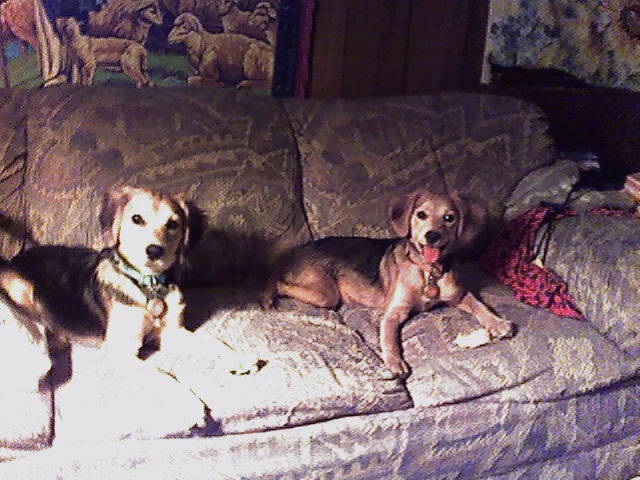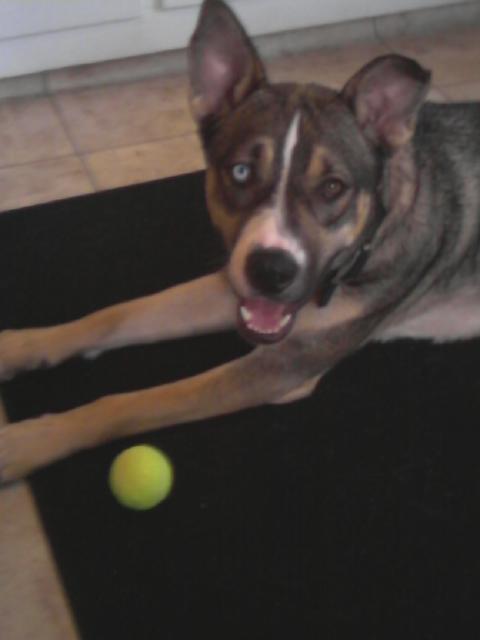QuestionQUESTION: Hello Dr. Hogan,
First, let me give you a quick background. we adopted a rescue when she was very young, 10-12 weeks??, who will be 2 yrs old soon. As best we can tell she is possibly border collie, German shepherd or husky (short hair but curled up tail), and definitely some hound because she will literally put her nose into the snow and find things -- which by her color we are guessing beagle.
She's gone through basic training as a pup. sits, stays, walks well on a leash, will "leave it". She does seem to know that I (or my husband) are the alpha. We can take food away from her with no problem, etc.
She is, however, a very skiddish dog -- can be startled by her own shadow or tail! Although we can deal with that, the problem is her aggression toward new people at the house. She is fine around people she's seen over and over again, but if our adult children have someone come over, for example -- particularly men, she has growled, snarled. I remove her from the situation because of my own fear that she could bite someone. When I remove her, it's not done in a coddled way, I don't say (oh its okay), but rather I tell her that is bad. Removing her is to be safe than sorry.
We do believe in reward training. As a matter of fact, a way that I've been trying to overcome her fears -- since we've noticed the hound traits, I have hidden treats in same room and then dark rooms. She does great with this, she likes the game, and I think it helped with her natural trait.
But what can we do about the aggression? As a pup I did take her to pet stores. But now I'm more fearful of her outward aggression when she sees someone that I just don't. It is just my husband and I most of the time at home, so it is not like we have alot of friends over, but the holidays certainly made it noticeable.
I would sure appreciate your help!
thanks in advance
Bridget
ANSWER: From what you have described it sounds to me as though you are dealing with a lack of socialization. Being a skittish dog would even deepen this type of behavior if not socialized adequately. First let me point out that the behavior of removing the dog from the situation in the manner in which you are is not the correct way to deal with this. Actually the coddling manner would be more advantages. I would recommend that you do not remove her. Sure it removes the threat by removing the dog but it is more likely to advance the aggression than to curtail it. If you want to teach the dog to accept people then it needs to be exposed to people in a controlled situation and shown the acceptable behavior and when it demonstrate that behavior it needs to be rewarded. Here is what you are doing:
" I remove her from the situation because of my own fear that she could bite someone. When I remove her, it's not done in a coddled way, I don't say (oh its okay), but rather I tell her that is bad. Removing her is to be safe than sorry."
I see no reward in this procedure whatsoever! So where is the "Reward" based training. All you've done is to discipline the dog by removing it from a social situation which it wants to be a part of or it would remove itself.
You must understand there are two processes that may occur with dogs and their behaviors. We can teach or train only new behaviors. You cannot train a dog to "not" demonstrate aggression. If this is an unacceptable behavior then you need to extinguish it by making the dog uncomfortable when it demonstrates it and then reward the dog when it doesn't demonstrate it. I know it sounds confusing but it is important that you differentiate between training/teaching and extinguishment. Preferably you will deal with both of these things in a sequential manner when dealing with this behavior. To make it simple you will extinguish the aggression and teach acceptance in the same lesson. This is where the ONE, TWO, GOOD DOG! protocol really shines through. Anytime you are dealing with aggressive issues you need to take necessary precautions to avoid accidental biting. You need to error on the side of caution. Having control of your dog with a lead is one way. Since I have assumed your dog is reacting this way because it desire to maintain its pack position when new people enter its territory. Men being the most threatening and therefor you get the reaction you witness. I could go on and explain all the reasons and details of what is happening and what needs to happen but that would get too involved so I will provide you with a simple protocol to follow to deal with this issue.
Set up a situation where you will have someone enter your home that would hopefully elicit this demonstration of aggression. Have your dog on a lead so you maintain physical control. Be close enough to your dog that you can touch it. As the person enters reassure the dog with praise. If the dog vocalizes, snarls, or postures aggressively reprimand accordingly. Usually a loud, firm short "a" sound like "AAAAAH" will usually stop the dog's demonstration. Immediately when the dog quits growling reward it with vocal praise and firm reassuring pats on the chest and side. Do not stroke the dog down the back or pat on the head. This process should take no more than a couple of seconds with the praise continuing for another 3 or 4. Repeat this process over and over. Have the person move around the room to get the dog to react. If the dog quits demonstrating the aggression after the third or forth time then simply continue the process without the reprimand. Instead just praise the dog. what we are accomplishing is extinguishing the demonstration of aggression with the reprimand and we are teaching the dog the proper way to accept new people by rewarding the dog for quitting the demonstration or not showing it in the first place. How the ONE, TWO, GOOD DOG! occurs. Reprimand (ONE), Dog ceasing demonstration of aggression (TWO), Praise (GOOD DOG!) You will want to get 15 or more reps of this in 3 to 5 minutes. Do not quit just because the dog doesn't show aggression continue the process until you get your 15 or more reps. You mention that you like to use treats. If you would like to instill a treat into the process then do so along with the pats and rubbing but continue the vocal praise. In order for reward to be most efficient in getting the dog to repeat the desired behavior it needs to follow that behavior within 1/2 of 1 second or almost simultaneously. That is why I say always use the vocal praise and then add the treat if you like. I'm not an advocate of using distracting rewards that take the focus off of me. I believe they only allow more area for confusion on the dogs behalf. I always have my hands and voice with me.
It is important that you teach the dog what is and isn't acceptable in your environment. By getting your dog out more and exposed to different social situation it will become more comfortable with these social changes within its environment and will simply be more accepting of strangers.
I'm not sure what you are attempting to accomplish with the training with the hidden treats in rooms but I see no apparent connection to this training and your aggression problem.
First I would like you to forget about "ALPHA" instead look at it as leadership. You can beat a dog into accepting "ALPHA" but that doesn't make the dog respect or honor you. Only by leading and teaching will you get the respect and honor necessary to be defined by your dog as the leader. By using this protocol on this issue and others you will become the leader and then when the dog becomes exposed to an unfamiliar stimulus it will naturally look to you for leadership instead of reacting out of instinct. If you need additional clarification or assistance please call. Dr. Hogan 509-991-0385 until 10 pm Pacific time.
---------- FOLLOW-UP ----------
QUESTION: Thank you Dr. Hogan. I certainly understand why you are explaining. I knew in my attempt to curb it that I was probably making it worse, but didn't know how to resolve it -- I do see where my removing her was discipline. thank you very much for the detailed process. My husband and I will certainly work on the approach as you describe.
B
AnswerYou are very welcome for the help and as I stated in the initial answer feel free to call if you want a more interactive answer. Due to the fact that training your dog really is about communication it is very difficult to just approach a single issue without making sure the owners understand the necessity for a "total" approach. This is why I recommend my booklet and have made it so cost effective. http://invincibleservices.com/html/one__two_good_dog_.html It really starts at the beginning with developing communication with your dog. I can guarantee that every simple step I take has been thought through and analyzed to make sure it produces results. I try not to discount different types of training methods but only to define that in order for a dog to learn anything these three simple things must occur. I have spent numerous hours of analytical observation of nearly every training method known to man and if successful they possess these three attributes. Often by being able to identify these attributes it allows us to streamline our communication with our dogs and therefor make things much more comfortable and more easily understood by our canine companion. Hope all works well for you and your dog!!!

 Dog Training And Punishment?
Question
Maya
hi there i have an akita X husky,
Dog Training And Punishment?
Question
Maya
hi there i have an akita X husky,
 bladder issues in rescue pups
Question
collie-shepherd pups
We have had two rescued s
bladder issues in rescue pups
Question
collie-shepherd pups
We have had two rescued s
 Chewing/Stealing
Question
Clarkie
my shih-tzu Clarkie is 21 month
Chewing/Stealing
Question
Clarkie
my shih-tzu Clarkie is 21 month
 Dog tackling
Question
My dog
I would like to know a technique or a t
Dog tackling
Question
My dog
I would like to know a technique or a t
 My mini-daschund is breaking ME in
Question
Tyson!
My miniature daschund is 8 months now,
My mini-daschund is breaking ME in
Question
Tyson!
My miniature daschund is 8 months now,